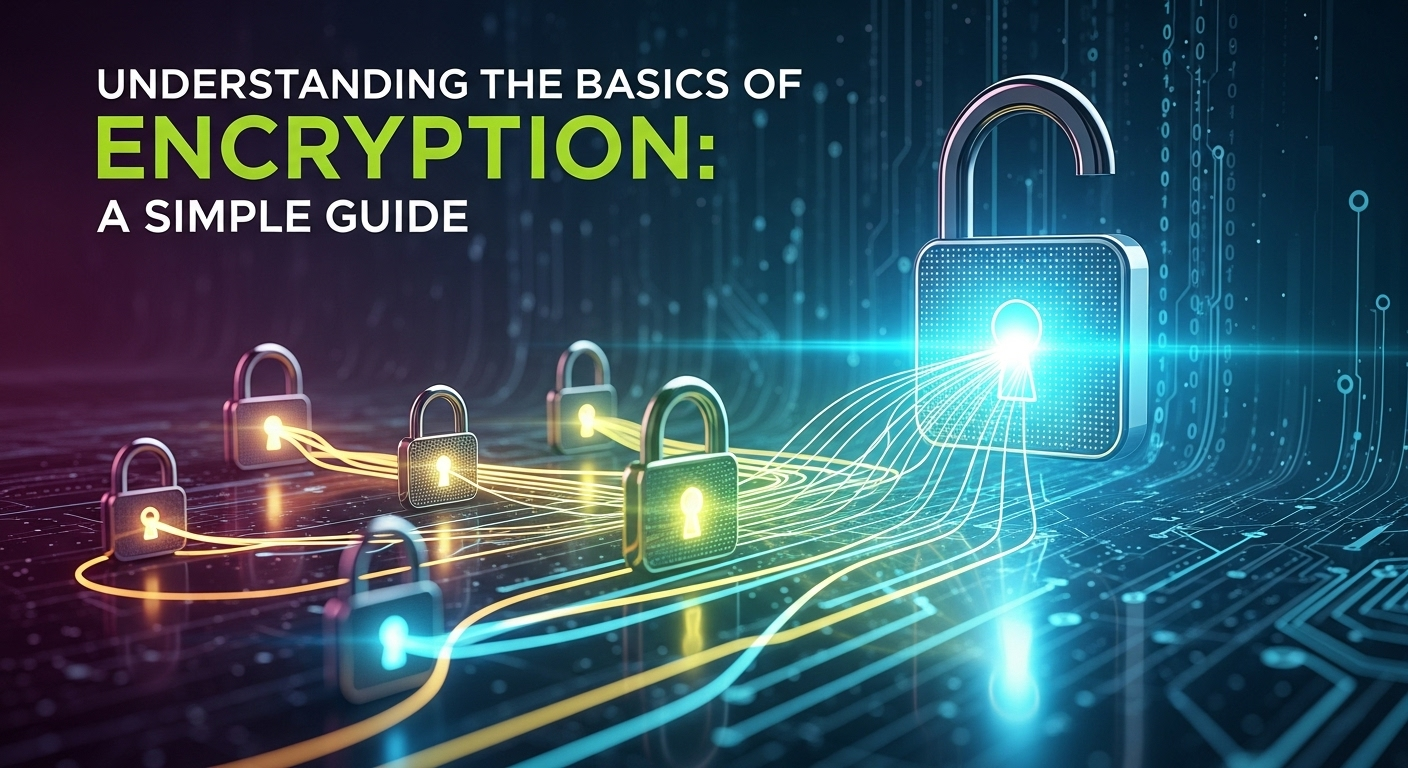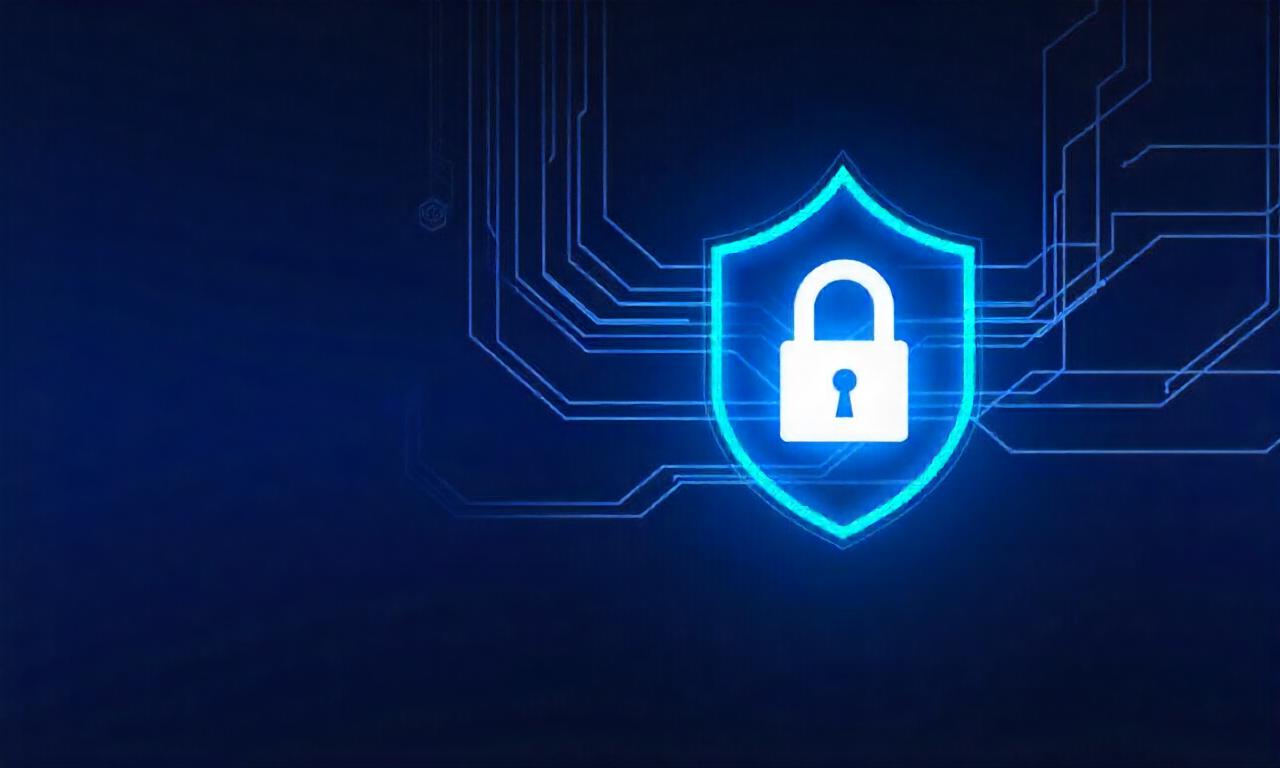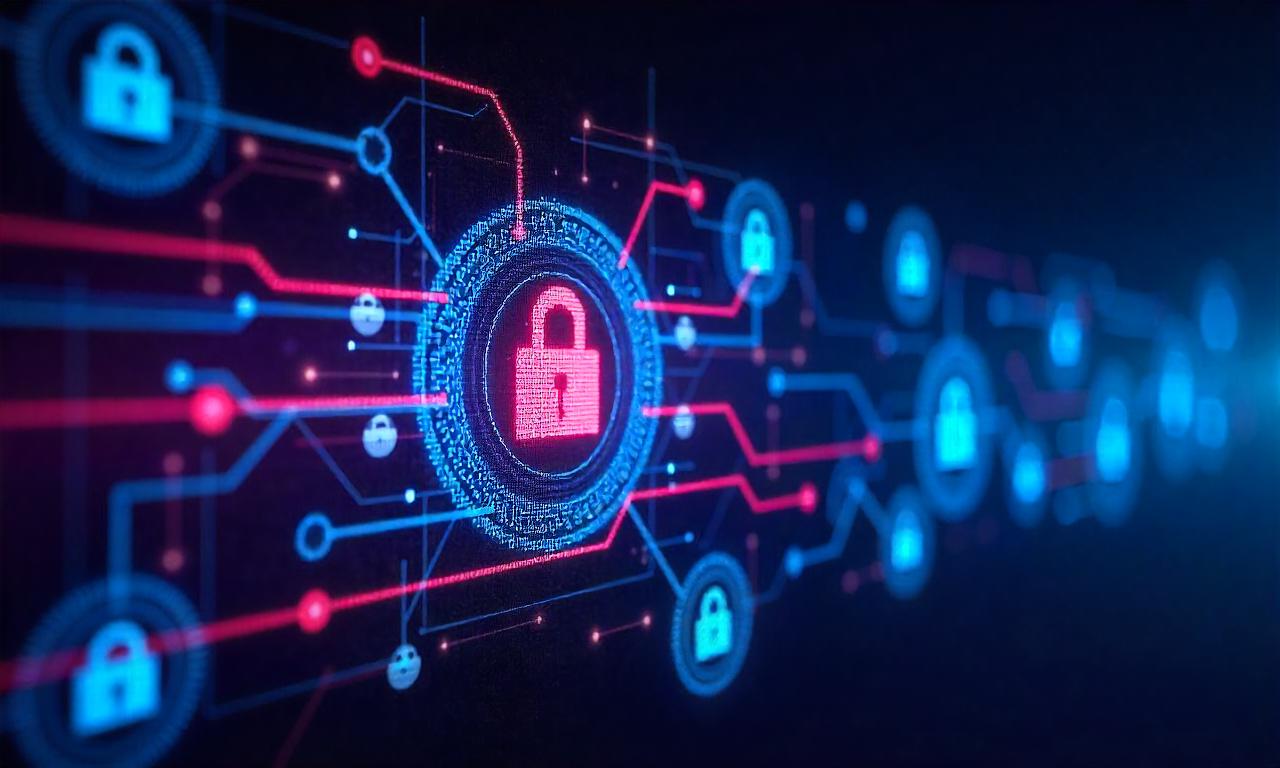In our increasingly digital world, we send messages, shop online, and store vast amounts of personal information on our devices and in the cloud. We do this with a level of trust that our sensitive data will remain private and secure. This trust isn’t built on hope; it’s built on a powerful, invisible shield called encryption. It’s the silent guardian of our digital lives, working tirelessly behind the scenes. For anyone navigating the modern internet, understanding the basics of encryption is no longer a niche technical skill but a fundamental aspect of digital literacy. This guide is designed to demystify this critical technology, breaking it down into simple, digestible concepts to show you how a string of scrambled characters keeps your digital world safe.
In today’s interconnected landscape, we share information at an unprecedented rate. From confidential business emails to personal photos and financial transactions, our data is constantly in motion or stored on various devices. This digital reality exposes us to significant risks, including data theft, unauthorized access, and privacy invasion. The fundamental technology that stands as our primary defense against these threats is encryption. Understanding its core principles is essential for appreciating the security measures that protect our daily online activities.
This comprehensive guide will walk you through the foundational concepts of encryption. We’ll explore what it is, why it’s critically important, and the key components that make it work. You will learn about the main types of encryption, see how they are applied in everyday technologies like HTTPS and secure messaging, and understand the crucial difference between encryption and its close cousin, hashing. By the end, you’ll have a clear and confident grasp of how this remarkable technology safeguards our digital identity and communications.
Table of Contents
ToggleWhat is Encryption and Why Does It Matter?
At its simplest, encryption is the process of converting readable data into an unreadable, scrambled format. The original, understandable data is called plaintext, and the scrambled, unintelligible version is called ciphertext. Think of it as writing a message in a secret code that only you and the intended recipient know how to decipher. If an unauthorized person intercepts the message, all they will see is a meaningless jumble of characters. To turn the ciphertext back into readable plaintext, a process called decryption is required, which is essentially the reverse of encryption.
The purpose of encryption extends beyond just keeping secrets. It provides a robust framework for ensuring data security through four key principles. The first is Confidentiality, which ensures that only authorized individuals can access the information. The second is Integrity, guaranteeing that the data has not been altered or tampered with during transit or storage. Third is Authenticity, which verifies that the sender and receiver are who they claim to be. Finally, Non-repudiation prevents a sender from denying that they sent a message. Together, these principles form the bedrock of secure digital communication.
In the modern digital age, the importance of encryption cannot be overstated. Every time you see a padlock icon in your browser’s address bar while visiting a website, you are witnessing encryption in action, securing your connection. It protects your credit card details during online purchases, secures your private conversations on messaging apps like WhatsApp and Signal, and shields your sensitive files stored on services like Google Drive or Dropbox. Without encryption, the internet as we know it—a platform for commerce, communication, and information sharing—would be a dangerously insecure environment, vulnerable to constant surveillance and theft.
The Core Components of Encryption
To truly grasp how encryption works, it’s essential to understand its fundamental building blocks. These components work in harmony to transform your sensitive information into a secure format. The three primary elements are the cryptographic algorithm, the key, and the distinction between plaintext and ciphertext. Each plays a distinct and vital role in the process, and the security of the entire system relies on their proper implementation and management.
A cryptographic algorithm is the mathematical formula or set of rules used to perform the encryption and decryption. It’s like a detailed recipe for scrambling and unscrambling data. Interestingly, most strong encryption algorithms, such as the Advanced Encryption Standard (AES), are publicly known and have been rigorously tested by experts worldwide. Their security doesn’t come from the secrecy of the method itself, but from the other crucial component: the key. This transparency allows the global security community to constantly vet and improve these algorithms, ensuring they remain resilient against attacks.
The key is the secret piece of information that makes the encryption unique. If the algorithm is the recipe, the key is the secret ingredient that makes your specific dish unique. It’s a string of characters (bits) that the algorithm uses to transform the plaintext into ciphertext and vice versa. The security of your encrypted data is entirely dependent on the secrecy and strength of this key. A longer key means there are more possible combinations, making it exponentially harder for an attacker to guess it through a brute-force attack, where they try every possible combination until they find the right one.
1. Plaintext vs. Ciphertext
Plaintext is the starting point of the encryption process. It is any data in its original, human-readable, or machine-readable format before it has been encrypted. This could be the content of an email, a password you enter into a website, a document on your hard drive, or a video stream. For example, the simple message “Meet me at noon” is plaintext. It is vulnerable in this state because anyone who intercepts it can immediately understand its meaning.
Ciphertext is the result of applying an encryption algorithm and a key to the plaintext. It is the unreadable, scrambled version of the original data. Following the previous example, the plaintext “Meet me at noon” might be transformed into ciphertext that looks like “bU8xRz+tY2PqL9sWvK4oEw==”. Without the correct decryption key, this string of characters is completely meaningless and provides no information about the original message. The primary goal of encryption is to ensure that even if data is intercepted, it remains in its secure ciphertext form, protecting its confidentiality.
2. The Role of Cryptographic Keys
Cryptographic keys are the linchpin of the entire encryption system. Their strength is often measured in bits (e.g., 128-bit, 256-bit). Each additional bit doubles the number of possible keys, creating an exponential increase in security. For instance, a 128-bit key has 2^128 possible combinations—a number so vast that it would take the most powerful supercomputers billions of years to guess. This is why using strong, sufficiently long keys is critical for robust security.
The management of these keys is just as important as their length. A process known as key management involves the secure generation, distribution, storage, and eventual destruction of keys. If a key is compromised, the security of all data encrypted with that key is nullified. This is why different encryption systems have been developed to address the challenge of how to share keys securely. The two primary approaches, symmetric and asymmetric encryption, are defined by how they use and manage their keys.
The Two Main Types of Encryption
While the goal of encryption is always to secure data, the methods for achieving it can be broadly categorized into two main types: Symmetric Encryption and Asymmetric Encryption. The fundamental difference between them lies in the keys they use. One system uses a single, shared key for both locking (encryption) and unlocking (decryption), while the other uses a mathematically linked pair of keys—one public and one private.
An easy way to visualize this is with physical analogies. Symmetric encryption is like a safe deposit box that requires a single key. To share the contents with someone, you must first securely give them a copy of that same key. This is fast and efficient once the key is shared. Asymmetric encryption is like having a personal mailbox with two keys. You have a public slot (the public key) where anyone can drop off a letter for you. However, only you possess the unique private key that can open the mailbox and retrieve the letters.
In practice, modern security systems like the protocol that powers HTTPS (SSL/TLS) cleverly combine both types to get the best of both worlds. They typically use the slower but more secure asymmetric encryption to safely exchange a temporary, single-use symmetric key. Once the secure channel is established and the symmetric key is shared, the rest of the communication session uses the much faster symmetric encryption to handle the bulk of the data transfer. This hybrid approach provides both robust security and high performance.
1. Symmetric Encryption: The Single-Key System
Symmetric encryption, also known as private-key cryptography, is the older and more straightforward of the two methods. It relies on a single secret key that is shared between the parties who need to communicate. This one key is used for both the encryption of the plaintext and the decryption of the ciphertext. Because it uses a single key and generally requires less computational power, symmetric encryption is extremely fast and efficient. This makes it ideal for encrypting large amounts of data, such as entire hard drives or large file transfers.
The primary challenge of symmetric encryption is secure key exchange. How do you get the secret key to the recipient without an attacker intercepting it first? If the key is intercepted, the entire security of the system is compromised. This is often called the “key distribution problem.” For this reason, symmetric encryption is most effective when the key can be shared through a secure channel beforehand or when it’s used on a local device (like encrypting your own laptop’s hard drive). Well-known symmetric algorithms include AES (Advanced Encryption Standard), DES (Data Encryption Standard), and 3DES. AES, particularly AES-256, is the current industry standard, trusted by governments and corporations worldwide.
2. Asymmetric Encryption: The Public-Key System
Asymmetric encryption, also known as public-key cryptography, was a revolutionary breakthrough designed to solve the key distribution problem inherent in symmetric systems. It uses a pair of mathematically related keys: a public key and a private key. The public key can be shared freely with anyone. The private key, as its name implies, must be kept absolutely secret by its owner. Data encrypted with the public key can only be decrypted by the corresponding private key.
This system elegantly solves the key exchange problem. If someone wants to send you a secure message, they use your publicly available key to encrypt it. Once encrypted, the message can only be unlocked with your secret private key, which you never have to share. This method is also the foundation for digital signatures, which verify authenticity. To create a signature, you encrypt a small piece of data (a hash of the message) with your private key. Anyone can then use your public key to decrypt it, proving that the message could only have come from you. The most famous asymmetric algorithm is RSA, named after its inventors Rivest, Shamir, and Adleman. While incredibly secure and versatile, asymmetric encryption is computationally intensive and much slower than symmetric encryption.
Real-World Applications of Encryption
Encryption is not just a theoretical concept; it’s a practical technology that is deeply integrated into our daily digital lives, often operating so seamlessly that we don’t even notice it. From browsing the web to sending a simple text message, you are constantly benefiting from its protection. These applications are what make the modern internet a viable platform for sensitive interactions, transforming it from an open postcard into a sealed, tamper-proof envelope.
Perhaps the most common application you encounter daily is HTTPS (Hypertext Transfer Protocol Secure). When you visit a website and see `https://` and a padlock icon in your browser’s address bar, it means your connection to that site is encrypted. This is typically achieved using a protocol called SSL (Secure Sockets Layer) or its modern successor, TLS (Transport Layer Security). This encrypts all the data flowing between your browser and the website’s server, protecting everything from login credentials to credit card numbers from eavesdroppers on the network.

Beyond web browsing, encryption is the backbone of many other services:
- Secure Messaging Apps: Services like Signal and WhatsApp use end-to-end encryption (E2EE). This ensures that only the sender and the intended recipient can read the messages. Not even the company that runs the service can access the message content.
- Virtual Private Networks (VPNs): A VPN creates an encrypted "tunnel" for all your internet traffic, routing it through a server run by the VPN provider. This hides your IP address and encrypts your data, protecting your privacy from your Internet Service Provider (ISP) and on public Wi-Fi networks.
- Disk Encryption: Operating systems like Windows (BitLocker) and macOS (FileVault) offer full-disk encryption. This encrypts the entire contents of your hard drive. If your laptop is ever lost or stolen, the data on it will be unreadable without your password, providing a powerful defense for your data at rest.
<strong>Email Encryption:</strong> Tools like PGP (Pretty Good Privacy*) allow users to encrypt the contents of their emails, ensuring that only the intended recipient can read them, even if the email account itself is compromised.
| Feature | Symmetric Encryption (Single Key) | Asymmetric Encryption (Key Pair) |
|---|---|---|
| Number of Keys | 1 (A single secret key is used for both encryption and decryption) | 2 (A public key for encryption, a private key for decryption) |
| Speed | Fast. Low computational overhead. | Slow. High computational overhead. |
| Key Management | Difficult. Securely sharing the single key is a major challenge. | Easy. The public key can be shared openly without compromising security. |
| Main Use Case | Encrypting large amounts of data (data in transit, data at rest). | Secure key exchange, digital signatures, and authentication. |
| Examples | AES, DES, 3DES, Blowfish | RSA, ECC (Elliptic Curve Cryptography), Diffie-Hellman |
Encryption vs. Hashing: Whats the Difference?
In discussions about cybersecurity, the terms “encryption” and “hashing” are often mentioned together, and sometimes even used interchangeably. While both are cryptographic processes that transform data, they serve fundamentally different purposes and operate in distinct ways. Understanding this difference is crucial for a complete picture of data security. Encryption is designed for confidentiality, while hashing is designed for integrity.
The most important distinction is that encryption is a two-way process. A piece of data that has been encrypted can be decrypted back to its original form using the appropriate key. The entire point of encrypting a message is so that the recipient can eventually read it. The process is reversible by design, provided you have the secret key. This makes it perfect for securing data that needs to be accessed again later, such as messages, files, and communication channels.
In contrast, hashing is a one-way process. A hash function takes an input of any size and produces a fixed-size string of characters, known as a hash value or a “digest.” This process is irreversible; you cannot take a hash value and computationally determine the original input. It’s like a digital fingerprint. Any tiny change in the input data will produce a completely different hash value. This one-way nature makes it unsuitable for sending secret messages but perfect for verifying data integrity.
1. When to Use Hashing
Hashing’s primary use case is to verify integrity, not to hide information. One of the most critical applications is password storage. Reputable websites do not store your password in plaintext. Instead, when you create an account, they run your password through a strong hash function (often with an added “salt” for more security) and store only the resulting hash. When you log in, they hash the password you enter and compare it to the stored hash. If they match, you’re granted access. This way, even if a company’s database is breached, the attackers only get a list of hashes, not the actual user passwords.
Another common use is for file integrity checks. When you download a large software file, the provider often lists a hash value (like an SHA-256 hash) on the download page. After downloading, you can run a hashing utility on the file on your own computer. If the hash you generate matches the one on the website, you can be confident that the file was not corrupted during download and has not been tampered with by a malicious actor.
2. When to Use Encryption
You use encryption whenever the goal is confidentiality—that is, when you need to protect the content of the data from unauthorized eyes but intend for it to be read later by an authorized party. This applies to both data in transit and data at rest. Data in transit is information moving across a network, such as your credit card details being sent to an e-commerce site via HTTPS. Encryption ensures that anyone eavesdropping on the network traffic cannot decipher the information.
Data at rest refers to information stored on a physical medium, like a hard drive, a USB stick, or a server in a data center. Encrypting your laptop’s hard drive with BitLocker or FileVault is a perfect example. The data is stored in a scrambled, unreadable format. When you boot up and enter your password, the system decrypts the files on the fly so you can use them. If the laptop is stolen, the thief has the physical drive, but without the decryption key (your password), the data remains a useless jumble of ciphertext.
Frequently Asked Questions (FAQ) about Encryption Basics
Q1: Is encryption 100% unbreakable?
A: In theory, no encryption is 100% “unbreakable.” However, in practice, modern encryption standards like AES-256 are computationally unbreakable with current technology. This means that using the fastest supercomputers in existence, it would take billions upon billions of years to guess the key through a brute-force attack. The security relies on the mathematical problem being too hard to solve in any reasonable timeframe. The primary threat to encrypted data usually comes from weak key management (e.g., losing a key or using a weak password) or implementation flaws, not from “breaking” the algorithm itself. A future threat on the horizon is quantum computing, which could potentially break some current forms of asymmetric encryption, leading researchers to develop new “quantum-resistant” algorithms.
Q2: What is end-to-end encryption (E2EE)?
A: End-to-end encryption (E2EE) is a specific implementation of encryption that ensures only the communicating users—the “ends” of the conversation—can read the messages. When you send a message using an E2EE service like Signal or WhatsApp, it is encrypted on your device and can only be decrypted on the recipient’s device. This means the service provider (e.g., Meta/Facebook) cannot access the content of your messages, even if they wanted to or were legally compelled to. They can see that you sent a message and to whom, but not what the message says. This provides the highest level of privacy for communications.
Q3: Is a VPN the same as encryption?
A: No, a VPN is a service that uses encryption as its core technology. A VPN (Virtual Private Network) creates a secure, encrypted tunnel between your device and a server operated by the VPN provider. All your internet traffic is routed through this tunnel. The encryption is the tool that makes the tunnel secure. The VPN is the overall service that provides privacy by masking your IP address and protecting your data from being snooped on by your ISP or on insecure networks like public Wi-Fi. So, while all VPNs use encryption, encryption itself is a much broader technology used in many other applications.
Q4: What is the most secure encryption algorithm?
A: There is no single “most secure” algorithm for all situations; the best choice depends on the specific use case. However, for symmetric encryption, AES (Advanced Encryption Standard) with a 256-bit key is the gold standard, trusted by governments and security experts globally. For asymmetric encryption, RSA (with key lengths of 2048 bits or higher) and ECC (Elliptic Curve Cryptography) are the leading standards. ECC offers similar security to RSA but with much shorter key lengths, making it more efficient and ideal for mobile and low-power devices. The security of any implementation depends not just on the algorithm but also on the key length and proper system configuration.
Conclusion
In an era defined by data, encryption has evolved from a military-grade technology into an essential, everyday utility that underpins our digital security and privacy. While the mathematics behind it can be incredibly complex, the fundamental concepts are straightforward and accessible. At its heart, encryption is a digital lock, transforming our sensitive information into indecipherable code that can only be read by those holding the correct key. By understanding the roles of plaintext, ciphertext, and cryptographic keys, you can better appreciate the invisible armor that protects you every day.
We’ve seen how the two main types, symmetric and asymmetric encryption, offer a powerful combination of speed and security that enables everything from secure online banking to private messaging. We’ve also clarified the crucial distinction between reversible encryption (for confidentiality) and one-way hashing (for integrity). These aren’t just abstract ideas; they are the working components of the secure internet we rely on.
Ultimately, having a basic grasp of encryption is a vital part of modern digital literacy. It empowers you to make more informed decisions about the services you use and to better understand the importance of practices like using strong passwords and enabling two-factor authentication. As our world becomes ever more connected, the role of encryption will only grow, continuing its silent, ceaseless work of keeping our digital lives private and secure.
***
Article Summary
This guide provides a comprehensive yet simple overview of encryption, the foundational technology for digital security. It begins by defining encryption as the process of converting readable data (plaintext) into a scrambled, unreadable format (ciphertext) to ensure confidentiality and data integrity. The article explains that encryption’s importance in the modern world is immense, protecting everything from online financial transactions to private messages.
The core components of encryption are broken down: the algorithm (the rules for scrambling data) and the cryptographic key (the secret piece of information that makes the encryption unique). The guide then details the two primary types of encryption. Symmetric encryption uses a single, shared key, making it fast and ideal for encrypting large amounts of data, though its main challenge is secure key distribution. Asymmetric encryption uses a pair of keys (one public, one private), which solves the key exchange problem and enables digital signatures, but is slower.
Furthermore, the article highlights real-world applications such as HTTPS for secure web browsing, end-to-end encryption in messaging apps, VPNs, and disk encryption. It also clearly distinguishes encryption—a two-way, reversible process for confidentiality—from hashing, a one-way, irreversible process used to verify data integrity (like storing passwords securely). Finally, a FAQ section addresses common questions about encryption’s breakability, end-to-end encryption, and the difference between a VPN and encryption, concluding that a basic understanding of this technology is crucial for digital literacy in today’s world.
















